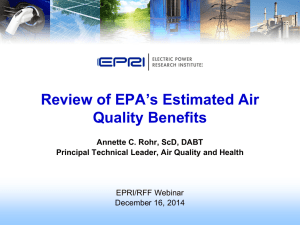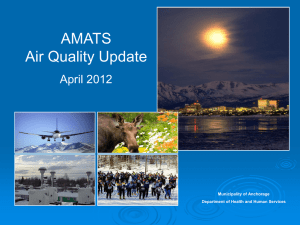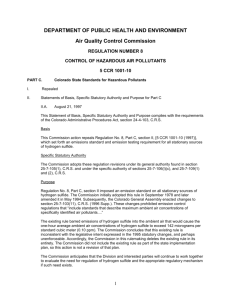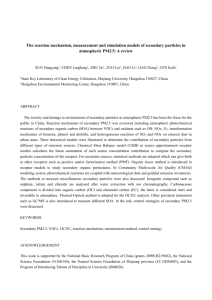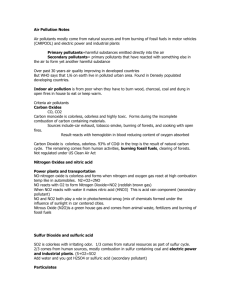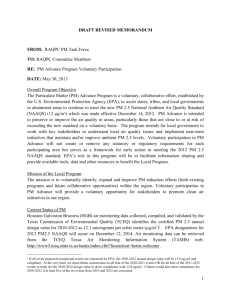abstract
advertisement
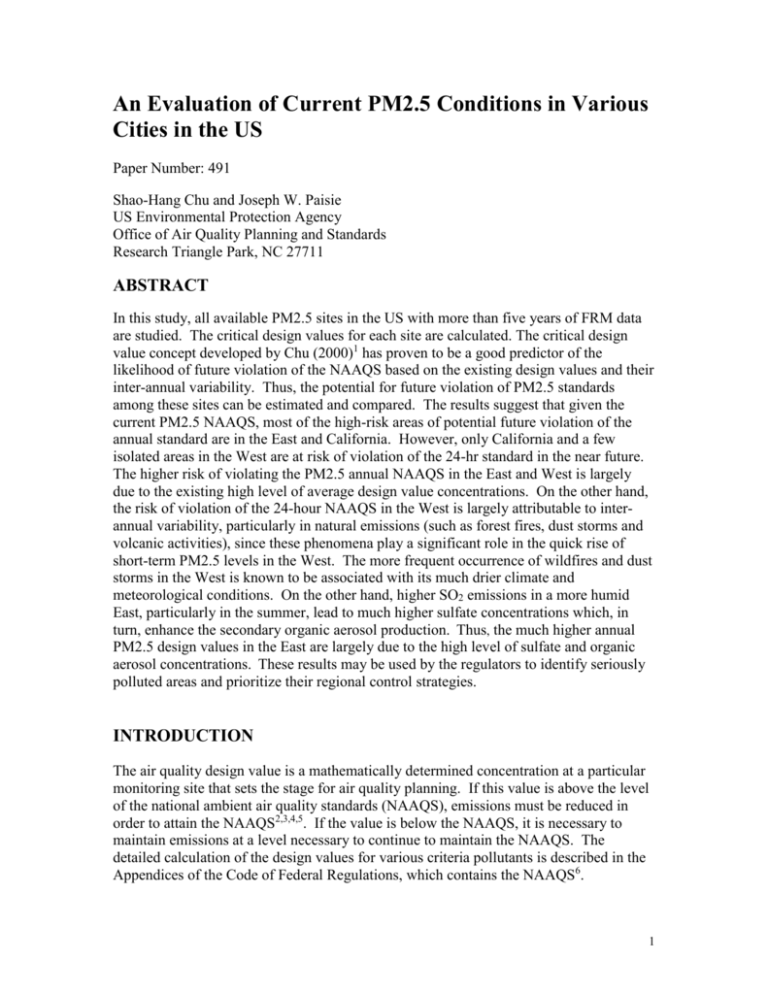
An Evaluation of Current PM2.5 Conditions in Various Cities in the US Paper Number: 491 Shao-Hang Chu and Joseph W. Paisie US Environmental Protection Agency Office of Air Quality Planning and Standards Research Triangle Park, NC 27711 ABSTRACT In this study, all available PM2.5 sites in the US with more than five years of FRM data are studied. The critical design values for each site are calculated. The critical design value concept developed by Chu (2000)1 has proven to be a good predictor of the likelihood of future violation of the NAAQS based on the existing design values and their inter-annual variability. Thus, the potential for future violation of PM2.5 standards among these sites can be estimated and compared. The results suggest that given the current PM2.5 NAAQS, most of the high-risk areas of potential future violation of the annual standard are in the East and California. However, only California and a few isolated areas in the West are at risk of violation of the 24-hr standard in the near future. The higher risk of violating the PM2.5 annual NAAQS in the East and West is largely due to the existing high level of average design value concentrations. On the other hand, the risk of violation of the 24-hour NAAQS in the West is largely attributable to interannual variability, particularly in natural emissions (such as forest fires, dust storms and volcanic activities), since these phenomena play a significant role in the quick rise of short-term PM2.5 levels in the West. The more frequent occurrence of wildfires and dust storms in the West is known to be associated with its much drier climate and meteorological conditions. On the other hand, higher SO2 emissions in a more humid East, particularly in the summer, lead to much higher sulfate concentrations which, in turn, enhance the secondary organic aerosol production. Thus, the much higher annual PM2.5 design values in the East are largely due to the high level of sulfate and organic aerosol concentrations. These results may be used by the regulators to identify seriously polluted areas and prioritize their regional control strategies. INTRODUCTION The air quality design value is a mathematically determined concentration at a particular monitoring site that sets the stage for air quality planning. If this value is above the level of the national ambient air quality standards (NAAQS), emissions must be reduced in order to attain the NAAQS2,3,4,5. If the value is below the NAAQS, it is necessary to maintain emissions at a level necessary to continue to maintain the NAAQS. The detailed calculation of the design values for various criteria pollutants is described in the Appendices of the Code of Federal Regulations, which contains the NAAQS6. 1 The design value, however, varies from year to year due to both the changes in anthropogenic pollutant emissions and natural variability, such as meteorological conditions, wildfires, dust storms, volcanic activities, etc. The critical design value concept first developed by Chu (2000)1 has proven to be a good statistical measure of the future violation of the NAAQS with a carefully selected risk factor. In this paper, an effort was made to analyze the ambient PM2.5 mass data from all available federal reference method (FRM) monitoring sites nationwide in the last 5 years. The critical design value and the probability of future violation for each site are calculated based on its current level and inter-annual variability. CRITICAL DESIGN VALUE APPROACH Chu (2000)1 gave a detailed description of the critical design value approach. Here, we will only briefly discuss the concept and its calculation method. A critical design value (CDV) is defined as the highest possible average design value (ADV) any site could have before it risks a future violation of the standard at a certain probability. If we assume that the design value (DV) is normally distributed and its coefficient of variation (CV) does not change in the near future, then we can write the relationship as: CDV = NAAQS/(1+tc*CV) (1) Where CDV is the critical design value, CV is the coefficient of variation of the annual design values adjusted for the long-term trend (the ratio of standard deviation divided by the mean design value in the past), and tc is the critical t-value corresponding to a probability, %, of exceeding the NAAQS in the future. Equation (1) says that the CDV is the highest ADV any monitoring site could have before it runs a risk of violating the NAAQS in the future at a probability of %. The percent probability, , is a risk factor chosen by the policy maker. One can choose either a more, or less, conservative value depending on how much risk one is willing to take. Using the air quality data collected in the past, one can calculate the annual design values and their mean and standard deviation. Thus, one can calculate the CDV for any site with a minimum of five years of data. Figure 1 is an example that illustrates the relationship among CDV, ADV and NAAQS at different CV’s. Here we have chosen a risk factor of 10% probability of future violation. In this example, we see that the CDV depends strongly on the average design value and its inter-annual variability as measured by the standard deviation. In Figure 1, it shows that higher risk of violation of the NAAQS can either result from an elevated ADV (as shown in the left panels) or an increased inter-annual variability (as shown in the right panels). Contrasting the upper and lower panels of Figure 1, we also see that whether a site will have a higher or lower risk of violating the NAAQS in the future depends on the difference between the ADV and CDV. Thus, unless a drastic change in emissions will 2 occur in the future, the CDV can be used as a yardstick to assess the likelihood of a site to violate the NAAQS in the future at a specific probability (in this example, it is one in ten). For this reason, this technique and the estimated CDV can be used as a planning tool for regulatory agencies to decide whether more or less controls are needed in a specific area. Figure 1. A RISK ASSESSMENT OF CURRENT PM2.5 CONDITIONS Applying this approach to evaluate current fine particulate conditions nationwide and their future risk of violating the NAAQS, the PM2.5 FRM data collected from 1999 to 3 2003 are analyzed. A tolerable risk factor of 10% probability of future violation of the NAAQS is used to calculate the CDVs for all FRM monitor sites with five years of complete data. The assessment is discussed and presented in the following figures. In Figure 2 the upper panels are longitudinal scatter plots of the paired ADVs and CDVs, and the lower panels are the inter-annual variability of the DVs at all available sites from California to Maine. They are plotted to see whether there is a difference from the West to East. The actual locations of these sites (color-coded by probability of execeedances) are shown in Figure 3. The probability of future violation of the NAAQS at each site is Figure 2. calculated by inverting the t-values using equation (1). Comparing the differences between these overlaid ADVs and CDVs (upper panels of Figure 2) and the actual probability of future violation of the NAAQS (Figure 3), we see clearly that, for potential 4 Figure 3. 5 future violation of the annual NAAQS, most of the high-risk areas are in the Eastern U.S. and California. However, for future 24-hr NAAQS violations, almost all high-risk areas are in California. This is a reflection of the fact that the constraining PM2.5 NAAQS is the annual form of the standard. It is of interest to note the major reasons behind this risk. From Figures 2 and 3 we see that at a large number of sites the current ADVs are above the CDVs. Among these sites, quite a few are already at or above the NAAQS. The lower panels of Figure 2 are longitudinal plots of the variability of design values at each site. It is worthy noting that, while the inter-annual variability of the annual design values is about the same in all high risk areas, the inter-annual variability of the 24-hr design values in the West is double that of the East. Combining the upper and lower panels of Figure 2 we see clearly that the higher risk of violating the PM2.5 annual NAAQS in the East and West is largely due to the existing high levels of average design value concentrations. However, the risk of violation of the 24-hour NAAQS in the West is largely attributable to inter-annual variability, particularly in natural emissions (such as forest fires, dust storms and volcanic activities), since these phenomena play a significant role in the quick rise of short-term PM2.5 levels in the West. The more frequent occurrence of wildfires and dust storms in the West is known to be associated with its much drier climate and meteorological conditions. On the other hand, higher SO2 emissions in a more humid East, particularly in the summer, lead to much higher sulfate concentrations, which, in turn, enhance the secondary organic aerosol production7,8,9,10. Thus, the much higher annual PM2.5 design values in the East are largely due to the high level of sulfate and organic aerosol concentrations. SUMMARY AND CONCLUSIONS In this paper, five years of PM2.5 FRM data nationwide were studied. The potential for future NAAQS violation was evaluated using the critical design value approach developed by Chu (2000)1. These results suggest that given the current PM2.5 NAAQS, most of the high-risk areas of potential future violation of the annual standard are in the East and California. However, only California and a few isolated areas in the West are at risk of future violation of 24-hr standard. The higher risk of violating the PM2.5 annual NAAQS in the East and West is largely due to the existing high levels of average design value concentrations. However, the risk of violation of the 24-hour NAAQS in the West, is largely attributable to inter-annual variability, particularly in natural emissions (such as forest fires, dust storms and volcanic activities), since these phenomena play a significant role in the quick rise of short-term PM2.5 levels in the West. The more frequent occurrence of wildfires and dust storms in the West is known to be associated with its much drier climate and meteorological conditions. On the other hand, higher SO2 emissions in a more humid East, particularly in the summer, lead to much higher sulfate concentrations which, in turn, enhance the secondary organic aerosol production. Thus, the much higher PM2.5 annual design values in the East are largely due to the high level of sulfate and organic aerosol concentrations. These results may be used by the regulators to identify seriously polluted areas and prioritize their regional control strategies. 6 ACKNOWLEDGMENTS The authors would like to give thanks to Dr. Terence Fitz-Simons and Dr. Karen Martin for reading the draft manuscript and Connie Chu for her help in preparing the manuscript. REFERENCES 1. Chu, Shao-Hang, Critical Design Value Estimation and Its Applications, Presented at the 93rd AWMA Annual Meeting, San Diego, CA, 2000. 2. US EPA, PM10 SIP Development Guideline. EPA-450/2-86-001, US Environmental Protection Agency, Research Triangle Park, NC 27711, 1986. 3. US EPA, Guideline on Air Quality Models (Revised). EPA-450/2-78-27 R. U.S. Environmental Protection Agency, Research Triangle Park, NC 27711, 1986. 4. US EPA, Guideline for the Interpretation of Ozone Air Quality Standards. EPA450/4-79-003, US Environmental Protection Agency, Research Triangle Park, NC 27711, 1979. 5. Curran, T.C. and W.M. Cox, Data Analysis Procedures for the Ozone NAAQS Statistical Format. J. Air Pollution Control Association, 1980. 6. Code of Federal Regulations, Protection of Environment, 40 CFR part 50, 1998. 7. Jang, M., Czoschke, N.M., Lee S., Kamens, R., Heterogeneous Atmospheric Aerosol Production by Acid-catalyzed Particle-phase Reaction. Science 298, 814-817, 2002. 8. Chu, Shao-Hang, PM2.5 Episodes as Observed in the Speciation Trends Network, Atmospheric Environment 38, 5237-5246, 2004. 9. Chu, Shao-Hang, Paisie, J.W., and Jang, B.W.-L., PM Data Analysis – a Comparison of Two Urban Areas: Fresno and Atlanta, Atmospheric Environment 38, 5155-3164, 2004. 10. Gao, S., Ng, N. L., Keywood, M., Varutbangkul, V., Bahreini, R., Nenes, A., He, J., Yoo, K. Y., Beauchamp, J. L., Hodyss, R. P., Flagan, R. C., Seinfeld, J. H., Particle Phase Acidity and Oligomer Formation in Secondary Organic Aerosol. Environ. Sci. Technol. 38(24); 6582-6589, 2004 KEYWORDS Critical design value, design value, inter-annual variability, PM2.5, risk assessment, probability 7
